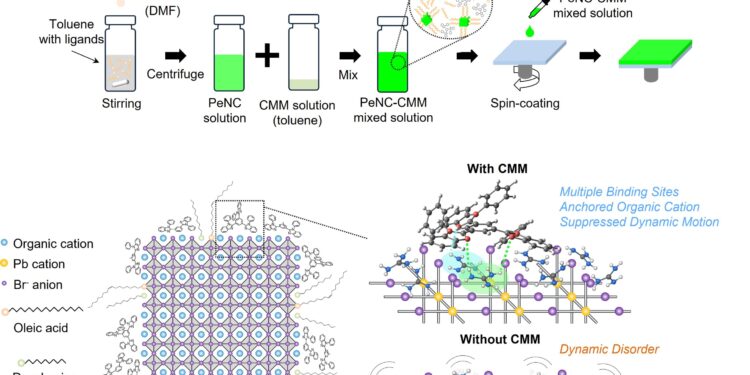Schematic of the process for fabricating thin films of perovskite nanocrystals with conjugated molecular multipods and the mechanism of network reinforcement on the surface of perovskite nanocrystals. Credit: Nature Communications (2024). DOI: 10.1038/s41467-024-49751-7
A research team has developed ultra-high-efficiency perovskite nanocrystal-based light-emitting diodes (LEDs) by strengthening the perovskite lattice and suppressing the low-frequency dynamics inherent in the material.
The research results were published in the journal Nature Communications on July 24. The team was led by Professor Tae-Woo Lee of the Department of Materials Science and Engineering at Seoul National University, in collaboration with Professor Andrew M. Rappe of the University of Pennsylvania,
Perovskite is a semiconductor material composed of cube-shaped nanocrystals consisting of organic cations, metal cations, and halogen elements. Perovskite-based light emitters have attracted attention as promising next-generation emitters due to their excellent color purity, tunability, and cost-effectiveness.
However, prior to 2014, perovskites were primarily used in solar cells because their luminescence was not bright enough to be visible at room temperature. Despite this limitation, Professor Lee recognized perovskite’s potential as a next-generation emitter early on and was awarded a portfolio of foundational patents for perovskite-based light-emitting materials in 2014.
In addition, in 2015, his team published the first research paper demonstrating the efficiency improvement of perovskite LEDs from only 0.1% to 8.53%, comparable to the level of phosphorescent OLEDs. This achievement has prompted researchers around the world to conduct intensive and in-depth research on improving the efficiency of perovskite emitters.
In 2022, Professor Lee’s team further refined the perovskite-based self-emissive devices, achieving an external quantum efficiency (EQE) of 28.9% (a theoretically achievable maximum), a peak brightness of 470,000 nits, and an operational lifetime of up to 30,000 hours. In preparation for commercialization, Professor Lee’s startup company SN Display Co. Ltd. demonstrated prototype TV and tablet displays at CES (Consumer Electronics Show) in 2022 and 2023, which attracted considerable interest from industry insiders.
However, the research team realized that a major challenge needed to be addressed: the reduction in luminescence efficiency due to the inherent ionic nature of perovskite. Unlike traditional inorganic semiconductors, perovskite materials are composed of weak ionic bonds, and the large-amplitude displacement of atoms in their crystal lattices can cause dynamic disorder. This dynamic disorder interferes with the radiative recombination process in perovskite materials, leading to exciton dissociation and reduced luminescence efficiency.
Despite the need to overcome this critical limitation, little research has been conducted on how dynamic disorder affects the luminescent properties of perovskites or on strategies to improve efficiency by reducing dynamic disorder.
(a) Electroluminescence spectrum of perovskite nanocrystal LEDs. (b) External quantum efficiency (up to 26.1%) of perovskite nanocrystal LEDs. (c) Plot of EQE coordinates versus CIEy coordinates for perovskite nanocrystal LEDs without light coupling enhancement techniques. Credit: Nature Communications (2024). DOI: 10.1038/s41467-024-49751-7
In collaboration with Professor Rappe of the University of Pennsylvania in the United States and Professor Omer Yaffe of the Weizmann Institute of Science in Israel, Professor Lee’s team suggested a new mechanism that improves the luminescence efficiency of perovskite emitters by incorporating conjugated molecular multipods (CMMs).
The mechanism is as follows: when CMM binds to the surface of the perovskite lattice, the lattice is strengthened, suppressing the low-frequency dynamics and reducing the dynamic disorder in the perovskite lattice. This consequence ultimately led to an improvement in the luminescence efficiency in perovskite-based materials.
A particularly notable achievement is the realization of very high efficiency LEDs with an EQE of 26.1%. This value is one of the highest in terms of efficiency of perovskite nanocrystal LEDs and is particularly significant because the efficiency improvement was achieved by improving the intrinsic emission efficiency of the material itself, rather than by designing the device structure that improves the light decoupling efficiency.
The perovskite emitters developed by Professor Lee’s team are recognized for their high potential as next-generation display emitters. Since green accounts for the largest portion of the Rec. 2020 color standard for ultra-high-definition displays, achieving high color purity and high-efficiency green emitters is essential for display development.
The LEDs developed by the research team exhibit electroluminescence wavelengths that come close to the green primary color of the Rec. 2020 standard. This achievement is expected to significantly accelerate the commercialization of next-generation displays.
Professor Lee said: “This research presents a novel materials-based approach to overcome the intrinsic limitations of perovskite-based light emitters. We anticipate that this will significantly contribute to the development of high-efficiency, long-life perovskite-based light-emitting devices and the commercialization of next-generation displays.”
Professor Rappe agreed: “Together, we have demonstrated the power of molecules to strengthen perovskites and make them better light emitters. By combining the powers of molecular chemistry, physics, mechanics and optics, we are inventing new materials that will lead us to a bright and energy-efficient future.”
More information:
Dong-Hyeok Kim et al, Surface-bonded molecular multipods strengthen halogenated perovskite network and enhance luminescence, Nature Communications (2024). DOI: 10.1038/s41467-024-49751-7
Provided by Seoul National University Faculty of Engineering
Quote: Researchers develop ultra-high-efficiency perovskite LEDs by strengthening the lattice (2024, August 30) retrieved August 30, 2024 from
This document is subject to copyright. Apart from any fair dealing for the purpose of private study or research, no part may be reproduced without written permission. The content is provided for informational purposes only.



